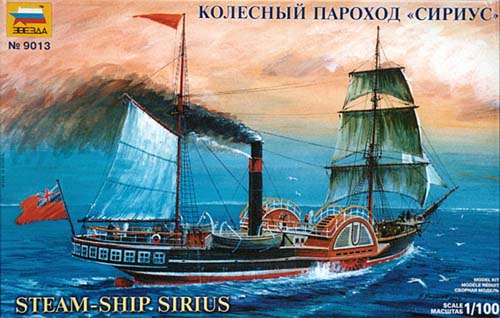
1:100 scale Sirius styrene kit by Zvezda.

Kit # 9013
Review by Christian Schönberger
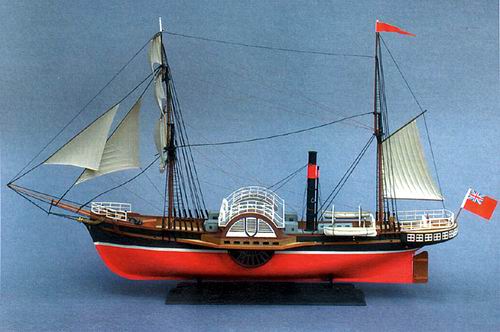
Assembled kit as shown on kit box.
A brief description of the original:
The wooden paddle steamer Sirius was built in 1836 by Robert Menzies & Son, Leith for the coasting trade of the St George Steam Packet Company of Hull. In 1838 she was chartered by the British and American Steam Packet Company of London.
She was the first ship to successfully cross the Atlantic ocean solely on steam power in 1838. In 1847 the ship ran aground in dense fog near Ballycotton Head in County Cork and was wrecked. Nineteen lives were lost.
The kit:
I could not find the year of production indicated by the kit, however I have read on one website that this is a new release (2003). The box indicates that the kit is distributed by Italeri, Italy.
The kit comes in a very strong box with rather old fashioned looking painted artwork on top. On the bottom we see photos of what seems to be some kind of pre-production model with one square yard and respective sail too many on the foremast. The model looks very nice though.
The contents are the hull halves and eight frames of styrene parts molded in beige-brown styrene of very good quality. The kit is not bagged. One frame of transparent styrene is provided, and two parts - the bottom of the support and a frame meant as a jig for the ratlines / shrouds - are molded in strong black styrene. A flag sheet, black rigging thread (standing rigging), and beige (running rigging), and a sheet of very crisp vacu-formed sails complete the kit.
There is a quite amount of flash. I could not spot any sink marks except on the two support parts, which is acceptable. Detail is fine and sharp and surfaces are smooth.
The paddle boxes, molded in reverse, represent a challenge. They feature fine horizontal wooden ribs, most of them are clogged on the visible surface by flash. Since paddle boxes are always one of the ‘eye catchers’ of a paddle steamer, this is quite frustrating and requires skill and patience to clean up.
On the positive side: many parts look very convincing including the very fine masts, yards and close-to-scale handrails.
The hull below waterline is totally smooth, the upper part has nice wood grain detail. The kit has many finely detailed parts for complete rigging detail.
Instructions are in Russian with (incomplete and poor) translations into English, German, French, Italian and Spanish. I noticed that in all translations the pioneering Atlantic crossing was said to have taken place in 1893 - in the Italian translation as late as 1983! Modelers with experience should have no problem assembling this kit. The drawings are what one might expect from a styrene kit: a bit crude but certainly helpful.
Note: the instructions do not show clearly how to glue-on the floats (paddles) to the wheels. Here is how: looking on the starboard wheel which turns clockwise, on the lower side the floats are positioned left (=aft) of the spoke that holds it. This way the water presses the float against the spoke instead of loosening it. The port side wheel is of course the mirror image.
Some of the kit parts are shown here:
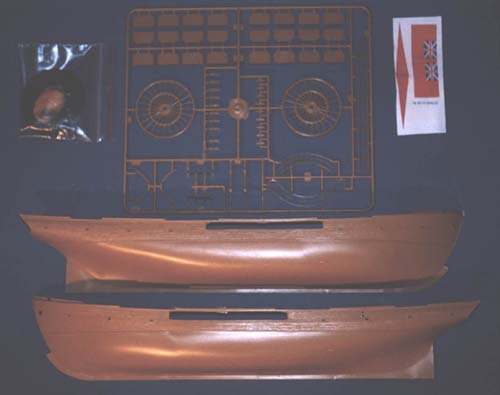
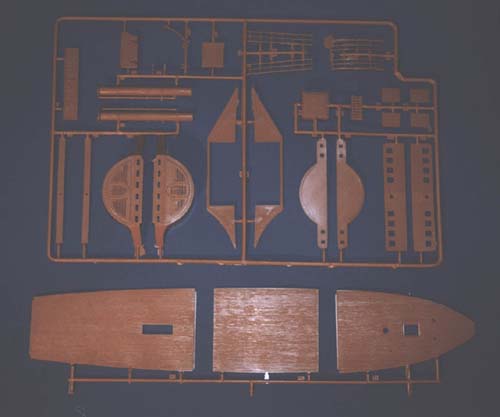
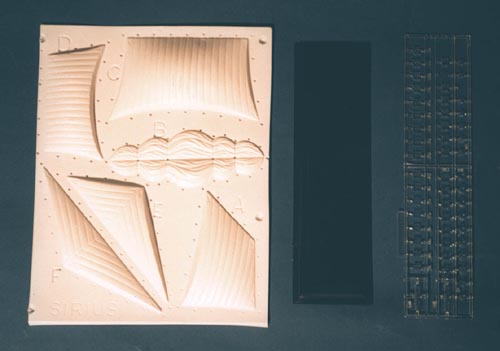
Accuracy/fixes:
I did some research on the Sirius, including asking paddle steamer experts, and it seems that information and data is hard to find or even nonexistent. Even if plans do exist, we most likely will not know how much they differ from the real ship. I have seen photos of three models - all agree on the general arrangement and the red lower hull - same as the Zvezda kit, but proportions vary a lot. It is very unlikely that ever any photograph of the Sirius has been taken. During her lifespan photography still was in its infancy.
The Merseyside Maritime Museum in Liverpool has a 1/96th scale Sirius model on exhibition. It is of 76,3 cm in overall length. The Zvezda kit does not come with the overall length of the model indicated but the instructions tell us that the original ship was 45,5m in length - the hull of the model - without the bowsprit - is about 45,5 scale meters long (easy to convert in 1/100th scale). So even with the bowsprit and the large flag on the stern, the Merseyside model and the Zvezda kit disagree on the ship's dimensions.
I have the feeling that the main (aft) mast of the Zvezda model is located too far aft. The existing models I know have the mast located more forward, and rigging would have too much slag if that far apart. The modeler might consider moving the aft mast about half an inch further forward. Of course this needs some knowledge and research.
The funnel color as suggested by the instructions is black with a red section just beneath the top. Two paintings of the vessel I saw show the funnel white with a black top. This sources might be considered in the choice of colors.
I am not a fan of vacu-formed sails, even if carefully painted. The modeler might consider leaving them off or replacing them with fine fabric, or paper.
I also recommend considering not using the supplied jig (or any other) for the shrouds / ratlines. Many articles in known books and magazines recommend applying the vertical shrouds on both sides - to avoid bending the mast - directly first and then gluing on the horizontal ratlines using a cardboard template with the positions drawn-on. This way all shrouds and ratlines are tight. This is just a suggestion of course.
Conclusions:
The kit is of very good quality, both regarding detail / molding quality and the quality of the styrene. I can not comment on its accuracy, but with some effort it can certainly be built into a beautiful model straight-out-of-the-box.
Highs:
High quality styrene.
Finely molded detail, including small rigging parts.
Lows:
A bit too much flash on some parts.
Poorly translated and sometimes unclear instructions.
Frames do not come in wrappers.
Rating: 8 out of 10
UPDATE (April, 2004):
The molds used for the Zvezda kit are in fact not new. Heller once released three kits having many parts in common. The kits included the paddle steamers Oriental Star and L’Occident (both kit number L-960, released under different names), the English Brigantine (sail only) and the Porquoi Pas (sail assisted screw driven). They were beautiful kits but the method of production resulted in some rather ill fitting parts I have been told. Since I did not build the kit, I cannot say if this holds true for the Zvezda Sirius as well. A fellow modeler kindly forwarded pictures of the Heller Oriental star and the Zvedzda Sirius kit seems to use all the exact same molds.
Looking at Sirius plans, which I came across, I come to the following conclusion:
The Zvezda kit only roughly resembles the Sirius. The original vessel had a narrower (or longer, depending on the way we look at the kit) hull with a sharper curve at the lower bow. The paddle wheels where located much further forward. The whole stern gallery, the rudder and the paddle boxes were of different shape and pattern. Even the correct bow figure holding the Sirius star is missing.
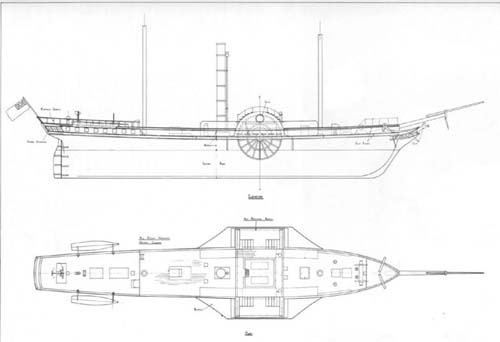
Side view and deck plan of the original Sirius.
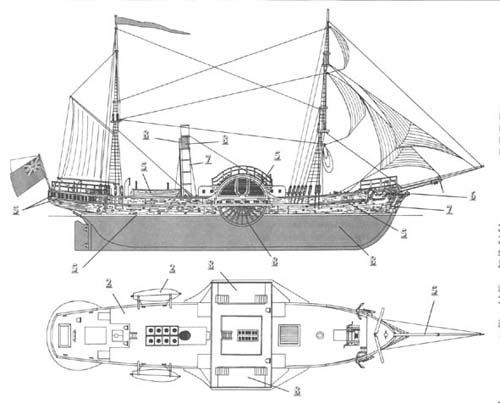
For comparison: the differences of proportions and details become obvious when we look at the drawings in the Zvezda kit instructions.
My final conclusion for the Zvezda kit: It builds to a very beautiful paddle steamer, but it definitely isn’t the Sirius. I don’t see any possibility for fixes either since the hull shape and all proportions are definitely way off.
The book Transatlantic Paddle Steamers by H.P. Spratt indicates the following dimensions for the Sirius:
overall length: 208 feet
length between perpendiculars: 178.4 feet
breadth of hull: 25.8 feet
breadth over paddle boxes: 47.25 feet
I changed the rating: 8 out of 10 for quality of parts and plastic, No rating for accuracy
I still recommend the kit since it builds into a very beautiful paddle steamer. I wouldn’t add the nameplate though.
Thanks to Scott, Gregg and William Swan for providing important information.
SC ~ 04/04